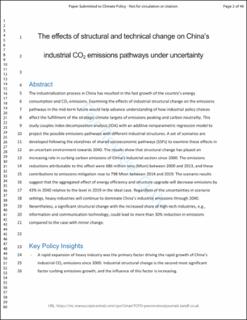| dc.contributor.author | Zhou, Wenji | |
| dc.contributor.author | Ren, Hongtao | |
| dc.contributor.author | Zhang, Chenfeng | |
| dc.contributor.author | Yu, Yadong | |
| dc.contributor.author | Cheng, Yunfei | |
| dc.contributor.author | Hu, Xiangping | |
| dc.contributor.author | Zhu, Bing | |
| dc.date.accessioned | 2023-02-08T10:23:05Z | |
| dc.date.available | 2023-02-08T10:23:05Z | |
| dc.date.created | 2022-11-21T09:03:36Z | |
| dc.date.issued | 2022 | |
| dc.identifier.citation | Climate Policy. 2022, . | en_US |
| dc.identifier.issn | 1469-3062 | |
| dc.identifier.uri | https://hdl.handle.net/11250/3049203 | |
| dc.description.abstract | The industrialization process in China has resulted in the fast growth of the country’s energy consumption and CO2 emissions. Examining the effects of industrial structural change on the emissions pathways in the mid-term future would help advance understanding of how industrial policy choices affect the fulfillment of the strategic climate targets of emissions peaking and carbon neutrality. This study couples index decomposition analysis (IDA) with an additive nonparametric regression model to project the possible emissions pathways with different industrial structures. It develops a set of scenarios following the storylines of shared socioeconomic pathways (SSPs) to examine these effects in an uncertain environment towards 2040. The results show that structural change has played an increasing role in curbing carbon emissions of China’s industrial sectors since 2000. The CO2 emissions reductions attributable to this effect were 686 million tons (Mton CO2) between 2000 and 2013, and these contributions to emission mitigation rose to 798 Mton between 2014 and 2019. The scenario results suggest that the aggregated effect of energy efficiency and structure upgrades will decrease emissions by 43% in 2040 relative to the level in 2019 in the ideal case. Regardless of the uncertainties in scenario settings, heavy industry will continue to dominate China’s industrial emissions through 2040. Nevertheless, a significant structural change with an increased share of high-tech industries, such as information and communication technology, could lead to more than a 30% reduction in emissions compared to cases with more minor changes in this sub-sector. | en_US |
| dc.language.iso | eng | en_US |
| dc.publisher | Taylor & Francis | en_US |
| dc.rights | Navngivelse 4.0 Internasjonal | * |
| dc.rights.uri | http://creativecommons.org/licenses/by/4.0/deed.no | * |
| dc.title | The effects of structural and technical change on China’s ndustrial CO2 emissions pathways under uncertainty | en_US |
| dc.title.alternative | The effects of structural and technical change on China’s ndustrial CO2 emissions pathways under uncertainty | en_US |
| dc.type | Peer reviewed | en_US |
| dc.type | Journal article | en_US |
| dc.description.version | acceptedVersion | en_US |
| dc.source.pagenumber | 16 | en_US |
| dc.source.journal | Climate Policy | en_US |
| dc.identifier.doi | https://doi.org/10.1080/14693062.2022.2147130 | |
| dc.identifier.cristin | 2076989 | |
| cristin.ispublished | true | |
| cristin.fulltext | postprint | |
| cristin.qualitycode | 1 | |

